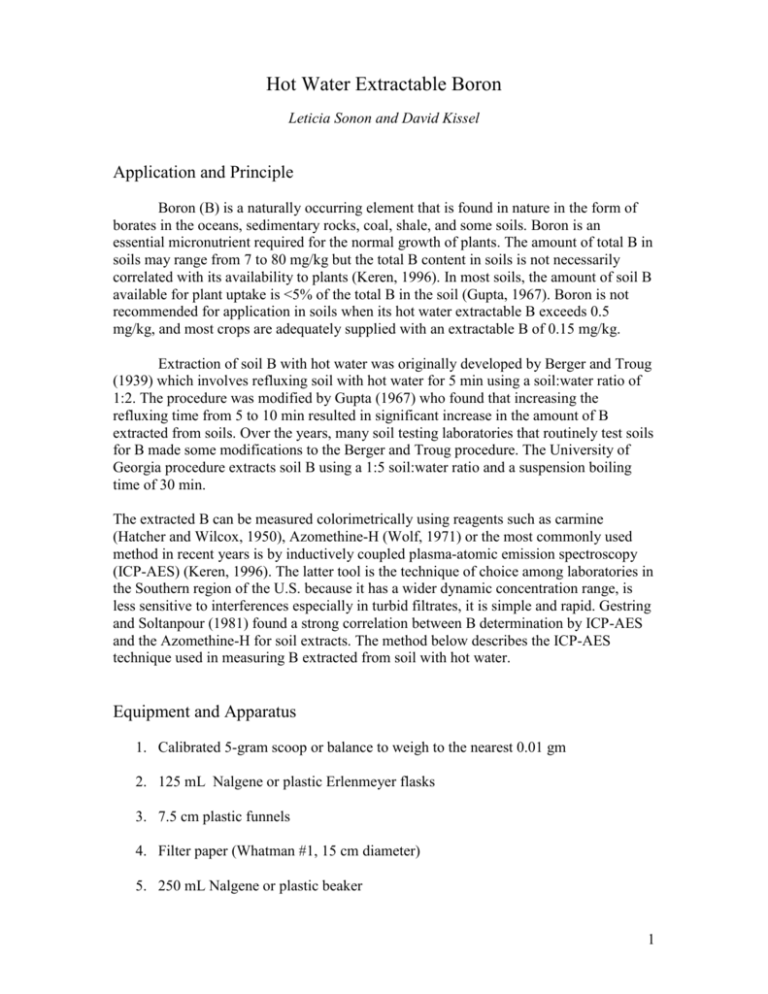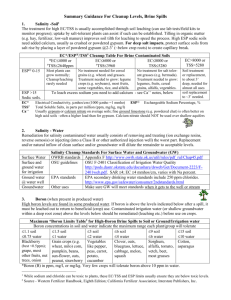HOT WATER EXTRACTABLE BORON
advertisement

Hot Water Extractable Boron Leticia Sonon and David Kissel Application and Principle Boron (B) is a naturally occurring element that is found in nature in the form of borates in the oceans, sedimentary rocks, coal, shale, and some soils. Boron is an essential micronutrient required for the normal growth of plants. The amount of total B in soils may range from 7 to 80 mg/kg but the total B content in soils is not necessarily correlated with its availability to plants (Keren, 1996). In most soils, the amount of soil B available for plant uptake is <5% of the total B in the soil (Gupta, 1967). Boron is not recommended for application in soils when its hot water extractable B exceeds 0.5 mg/kg, and most crops are adequately supplied with an extractable B of 0.15 mg/kg. Extraction of soil B with hot water was originally developed by Berger and Troug (1939) which involves refluxing soil with hot water for 5 min using a soil:water ratio of 1:2. The procedure was modified by Gupta (1967) who found that increasing the refluxing time from 5 to 10 min resulted in significant increase in the amount of B extracted from soils. Over the years, many soil testing laboratories that routinely test soils for B made some modifications to the Berger and Troug procedure. The University of Georgia procedure extracts soil B using a 1:5 soil:water ratio and a suspension boiling time of 30 min. The extracted B can be measured colorimetrically using reagents such as carmine (Hatcher and Wilcox, 1950), Azomethine-H (Wolf, 1971) or the most commonly used method in recent years is by inductively coupled plasma-atomic emission spectroscopy (ICP-AES) (Keren, 1996). The latter tool is the technique of choice among laboratories in the Southern region of the U.S. because it has a wider dynamic concentration range, is less sensitive to interferences especially in turbid filtrates, it is simple and rapid. Gestring and Soltanpour (1981) found a strong correlation between B determination by ICP-AES and the Azomethine-H for soil extracts. The method below describes the ICP-AES technique used in measuring B extracted from soil with hot water. Equipment and Apparatus 1. Calibrated 5-gram scoop or balance to weigh to the nearest 0.01 gm 2. 125 mL Nalgene or plastic Erlenmeyer flasks 3. 7.5 cm plastic funnels 4. Filter paper (Whatman #1, 15 cm diameter) 5. 250 mL Nalgene or plastic beaker 1 6. Deionized water dispenser 7. Reciprocal hot water shaking bath 8. Instrumentation for boron analysis a. Thermo Jarrell-Ash model 61E ICP b. Thermo Jarrell-Ash Auto sampler 300 c. 48 position rectangular sample rack Reagents 1. Boron Stock Solution (1000 mg/L): Use NIST traceable single element plasma grade standard. 2. Boron Stock solution (1000 mg/L): Use NIST traceable single element plasma grade standard. 3. Boron Stock solution (10 mg/L): Pipette 10 mL of the 1000 mg/L B stock solution into a 1 L volumetric flask. Make to volume with deionized water and mix well. Store in a plastic bottle. 4. Boron Working Standards: Pipette 0, 1, and 3 mL of the 10 mg/L B stock solution and bring to 100 mL volume with deionized water. This results to standard B concentrations of 0, 0.10, and 0.30 mg B/L respectively. Procedure Extraction 1. Scoop 4 cm3 or weigh 5 g of air-dried, 2-mm sieved soil into 125 mL plastic flasks. 2. Add 25 mL deionized water. 3. Load the flasks on a reciprocal hot water shaking bath and shake the slurries for 30 miniutes at 80oC. 4. Filter into 125 mL plastic Erlenmeyer flasks, using Whatman #1, 150-mm diameter filter paper. Oftentimes, the supernatant is turbid due to colloidal materials that pass through the filter, check the filtrate for clarity and refilter if necessary. Analysis 2 1. Calibrate the ICP with deionized water (Type 1) as blank, and the 0.30 mg/L B standards. 2. Use the 0.10 mg/L standard as a curve verification check. Analyze this standard immediately after calibration and after the last soil sample. 3. Analyze the filtrate on the ICP emission spectrograph. 4. Prepare one duplicate sample and one quality control sample with each set of samples analyzed. Calculations 1. Soil Bmg/kg = ICP extract B reading x 25/5 2. Soil Blbs/acre = soil Bmg/kg x 2 where 25 is the volume of deionized water added, 5 is the weight of soil sample, and 2 converts mg/kg to lbs/acre (for those laboratories that give reports in lbs/acre). Analytical Performance Range and Sensitivity 1. Boron was measured in ICP-AES (Thermo Jarrell-Ash Enviro 61E ICAP Spectrometer) at a wavelength of 249.6 nm with a calculated method detection limit of 0.01 mg B L-1. The ICP technique proved to be simple and fast, and suitable for B determination from an aqueous extract. Precision and Accuracy 1. Soil samples from the North American Proficiency Testing Program (NAPT) with known B concentrations were re-analyzed following the hot water extraction and ICP method. Extraction and B measurement were done in eight replications, and data were compared with values reported by NAPT (table below). The data were highly precise between replications, and the median values were comparable with those with NAPT implying its accuracy. UGA Lab Measurements Soil NAPT Median mg kg-1 No. of Measurements Median mg kg-1 Std. deviation NAPT 2009-101 0.500 8 0.535 0.026 NAPT 2009-104 0.200 8 0.226 0.010 3 NAPT 2009-116 UGA Lab Check Soil 0.715 8 0.685 0.046 - 8 0.093 0.025 2. For routine soil B analysis, laboratories may establish limits of acceptability such as values of duplicate samples must agree within 20% of the average of the two values. 3. The low level of boron generally extracted from soils poses a challenge on accuracy of measurement as it gets closer to the instrument’s detection limit. It is, therefore, recommended that determining boron needs by plant analysis is equally or even more important than soil analysis. Interferences 1. Care must be taken to filter samples properly to avoid clogging of the nebulizer by colloids in the extract. 2. If glassware is used, it should be washed with a 1:1 mixture of boiling HCl and deionized water before use. Interpretation 1. The University of Georgia uses the following soil test ratings for hot water extractable B: Crop All crops Soil B Test Level, mg/kg Low Adequate 0.0-0.10 0.15 2. Boron is routinely recommended for alfalfa, cotton, peanuts, all commercial vegetable crops, reseeding clover or where clover seed are to be harvested. It is not advisable to exceed the rates recommended for the specific crops, as boron toxicity can occur from excessive applications. When the soil test boron level exceeds 0.5 mg/kg, boron should not be applied irrespective of the crop. Crops differ in the amount of boron they can tolerate. Sensitive crops are soybeans, peaches, and strawberries. Some of the tolerant crops are alfalfa, clovers, and root crops. Corn, cotton, tobacco, tomatoes and small grains are intermediate. Effects of Storage 1. For accurate and reproducible B analyses, it is important to use non-borosilicate containers or low-B (aged) glasswares for B standards and extracts. 4 Safety Disposal 1. The chemicals used in this procedure pose no safety risk and therefore can be stored and disposed of according to routine laboratory procedures. References Berger, K.C. and Troug, E. 1939. Boron determination in soils and plants using the quinalizarin reaction. Ind. Eng. Chem. 11:540-545. Gestring, W.D. and P. N. Soltanpour. 1981. Boron Analysis in Soil Extracts and Plant Tissue by Plasma Emission Spectroscopy. Comm. Soil Sci. Plant Anal. 12(8): 733-742. Gupta, U. C. 1967. A Simplified Method for Determining Hot Water-soluble Boron in Podzol Soils. Soil Sci. 103:424-428. Hatcher, J.T. and Wilcox, L.V. 1950. Colorimetric determination of boron using carmine. Anal. Chem. 22:567-569. Keren, R. 1996. Boron. In D.L. Sparks (ed.) Methods of soil analysis, Part 3. Chemical methods. Soil Science Society of America, Book series no. 5. Wolf, B. 1971. The determination of boron in soil extracts, plant materials, composts, manures, water, and nutrient solutions. Soil Sci. Plant Anal. 2:363-374. 5






